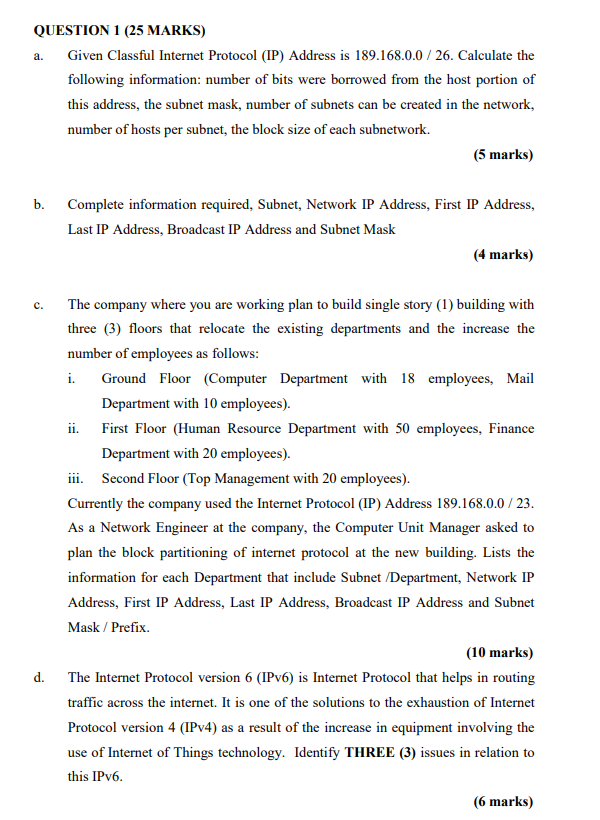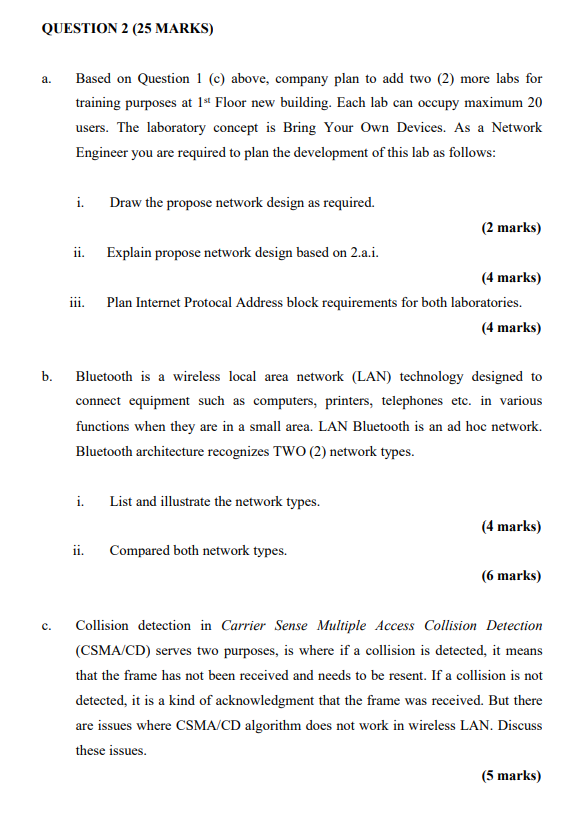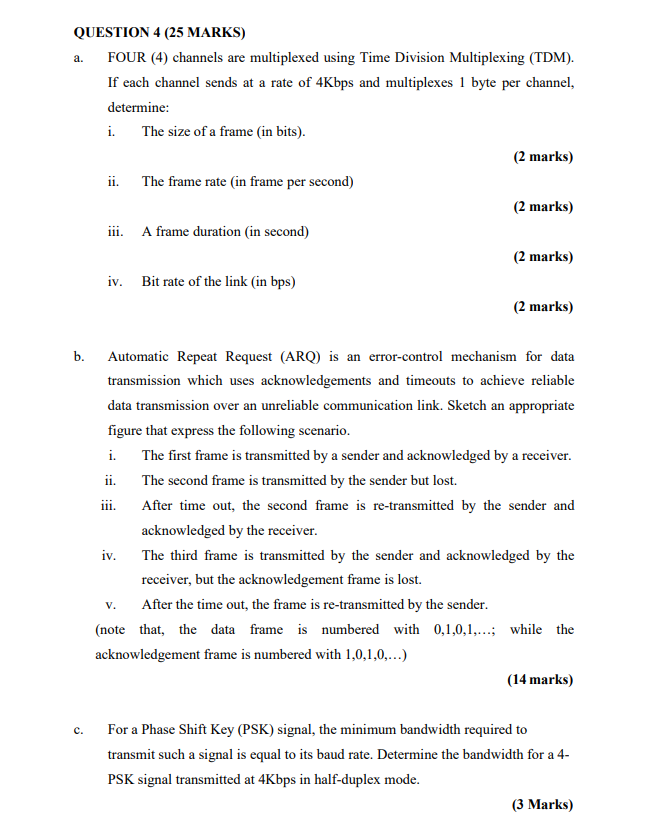communication & networking




QUESTION 1 (25 MARKS) a. Given Classful Internet Protocol (IP) Address is 189.168.0.0 / 26. Calculate the following information: number of bits were borrowed from the host portion of this address, the subnet mask, number of subnets can be created in the network, number of hosts per subnet, the block size of each subnetwork. (5 marks) b. Complete information required, Subnet, Network IP Address, First IP Address, Last IP Address, Broadcast IP Address and Subnet Mask (4 marks) c. The company where you are working plan to build single story (1) building with three (3) floors that relocate the existing departments and the increase the number of employees as follows: i. Ground Floor (Computer Department with 18 employees, Mail Department with 10 employees). ii. First Floor (Human Resource Department with 50 employees, Finance Department with 20 employees). iii. Second Floor (Top Management with 20 employees). Currently the company used the Internet Protocol (IP) Address 189.168.0.0 / 23. As a Network Engineer at the company, the Computer Unit Manager asked to plan the block partitioning of internet protocol at the new building. Lists the information for each Department that include Subnet Department, Network IP Address, First IP Address, Last IP Address, Broadcast IP Address and Subnet Mask /Prefix. (10 marks) The Internet Protocol version 6 (IPv6) is Internet Protocol that helps in routing traffic across the internet. It is one of the solutions to the exhaustion of Internet Protocol version 4 (IPv4) as a result of the increase in equipment involving the use of Internet of Things technology. Identify THREE (3) issues in relation to this IPv6. (6 marks) d. QUESTION 2 (25 MARKS) a. Based on Question 1 (C) above, company plan to add two (2) more labs for training purposes at 1" Floor new building. Each lab can occupy maximum 20 users. The laboratory concept is Bring Your Own Devices. As a Network Engineer you are required to plan the development of this lab as follows: i. Draw the propose network design as required. (2 marks) ii. Explain propose network design based on 2.a.i. (4 marks) iii. Plan Internet Protocal Address block requirements for both laboratories. (4 marks) b. Bluetooth is a wireless local area network (LAN) technology designed to connect equipment such as computers, printers, telephones etc. in various functions when they are in a small area. LAN Bluetooth is an ad hoc network. Bluetooth architecture recognizes TWO (2) network types. i. List and illustrate the network types. (4 marks) ii. Compared both network types. (6 marks) c. Collision detection in Carrier Sense Multiple Access Collision Detection (CSMA/CD) serves two purposes, is where if a collision is detected, it means that the frame has not been received and needs to be resent. If a collision is not detected, it is a kind of acknowledgment that the frame was received. But there are issues where CSMA/CD algorithm does not work in wireless LAN. Discuss these issues. (5 marks) QUESTION 3 (25 MARKS) 10 ms 10V Time Figure 1: A signal a. Based on Figure 1, calculate the amplitude, period, and frequency of a given signal. (11 marks) b. A device is sending out data at the rate of 4Kbps. Answers the following questions: i. How long does it take to send out 100 bits? ii. How long does it take to send a file of 10 characters? (5 marks) C. Based on a given data stream of 1011011011011011, sketch the related graph of the following line coding schemes. Assume the last signal level has been positive. i. Unipolar (2 marks) ii. Multi-transitions (2 marks) iii. NRZ-I (2 marks) iv. Manchester Scheme (2 marks) 2B1Q Scheme (2 marks) V. QUESTION 4 (25 MARKS) a. FOUR (4) channels are multiplexed using Time Division Multiplexing (TDM). If each channel sends at a rate of 4Kbps and multiplexes 1 byte per channel, determine: i. The size of a frame (in bits). (2 marks) ii. The frame rate (in frame per second) (2 marks) iii. A frame duration (in second) (2 marks) iv. Bit rate of the link in bps) (2 marks) b. Automatic Repeat Request (ARQ) is an error-control mechanism for data transmission which uses acknowledgements and timeouts to achieve reliable data transmission over an unreliable communication link. Sketch an appropriate figure that express the following scenario. i. The first frame is transmitted by a sender and acknowledged by a receiver. ii. The second frame is transmitted by the sender but lost. iii. After time out, the second frame is re-transmitted by the sender and acknowledged by the receiver. iv. The third frame is transmitted by the sender and acknowledged by the receiver, but the acknowledgement frame is lost. After the time out, the frame is re-transmitted by the sender. (note that, the data frame is numbered with 0,1,0,1,..., while the acknowledgement frame is numbered with 1,0,1,0,...) (14 marks) V. c. For a Phase Shift Key (PSK) signal, the minimum bandwidth required to transmit such a signal is equal to its baud rate. Determine the bandwidth for a 4- PSK signal transmitted at 4Kbps in half-duplex mode. (3 Marks) QUESTION 1 (25 MARKS) a. Given Classful Internet Protocol (IP) Address is 189.168.0.0 / 26. Calculate the following information: number of bits were borrowed from the host portion of this address, the subnet mask, number of subnets can be created in the network, number of hosts per subnet, the block size of each subnetwork. (5 marks) b. Complete information required, Subnet, Network IP Address, First IP Address, Last IP Address, Broadcast IP Address and Subnet Mask (4 marks) c. The company where you are working plan to build single story (1) building with three (3) floors that relocate the existing departments and the increase the number of employees as follows: i. Ground Floor (Computer Department with 18 employees, Mail Department with 10 employees). ii. First Floor (Human Resource Department with 50 employees, Finance Department with 20 employees). iii. Second Floor (Top Management with 20 employees). Currently the company used the Internet Protocol (IP) Address 189.168.0.0 / 23. As a Network Engineer at the company, the Computer Unit Manager asked to plan the block partitioning of internet protocol at the new building. Lists the information for each Department that include Subnet Department, Network IP Address, First IP Address, Last IP Address, Broadcast IP Address and Subnet Mask /Prefix. (10 marks) The Internet Protocol version 6 (IPv6) is Internet Protocol that helps in routing traffic across the internet. It is one of the solutions to the exhaustion of Internet Protocol version 4 (IPv4) as a result of the increase in equipment involving the use of Internet of Things technology. Identify THREE (3) issues in relation to this IPv6. (6 marks) d. QUESTION 2 (25 MARKS) a. Based on Question 1 (C) above, company plan to add two (2) more labs for training purposes at 1" Floor new building. Each lab can occupy maximum 20 users. The laboratory concept is Bring Your Own Devices. As a Network Engineer you are required to plan the development of this lab as follows: i. Draw the propose network design as required. (2 marks) ii. Explain propose network design based on 2.a.i. (4 marks) iii. Plan Internet Protocal Address block requirements for both laboratories. (4 marks) b. Bluetooth is a wireless local area network (LAN) technology designed to connect equipment such as computers, printers, telephones etc. in various functions when they are in a small area. LAN Bluetooth is an ad hoc network. Bluetooth architecture recognizes TWO (2) network types. i. List and illustrate the network types. (4 marks) ii. Compared both network types. (6 marks) c. Collision detection in Carrier Sense Multiple Access Collision Detection (CSMA/CD) serves two purposes, is where if a collision is detected, it means that the frame has not been received and needs to be resent. If a collision is not detected, it is a kind of acknowledgment that the frame was received. But there are issues where CSMA/CD algorithm does not work in wireless LAN. Discuss these issues. (5 marks) QUESTION 3 (25 MARKS) 10 ms 10V Time Figure 1: A signal a. Based on Figure 1, calculate the amplitude, period, and frequency of a given signal. (11 marks) b. A device is sending out data at the rate of 4Kbps. Answers the following questions: i. How long does it take to send out 100 bits? ii. How long does it take to send a file of 10 characters? (5 marks) C. Based on a given data stream of 1011011011011011, sketch the related graph of the following line coding schemes. Assume the last signal level has been positive. i. Unipolar (2 marks) ii. Multi-transitions (2 marks) iii. NRZ-I (2 marks) iv. Manchester Scheme (2 marks) 2B1Q Scheme (2 marks) V. QUESTION 4 (25 MARKS) a. FOUR (4) channels are multiplexed using Time Division Multiplexing (TDM). If each channel sends at a rate of 4Kbps and multiplexes 1 byte per channel, determine: i. The size of a frame (in bits). (2 marks) ii. The frame rate (in frame per second) (2 marks) iii. A frame duration (in second) (2 marks) iv. Bit rate of the link in bps) (2 marks) b. Automatic Repeat Request (ARQ) is an error-control mechanism for data transmission which uses acknowledgements and timeouts to achieve reliable data transmission over an unreliable communication link. Sketch an appropriate figure that express the following scenario. i. The first frame is transmitted by a sender and acknowledged by a receiver. ii. The second frame is transmitted by the sender but lost. iii. After time out, the second frame is re-transmitted by the sender and acknowledged by the receiver. iv. The third frame is transmitted by the sender and acknowledged by the receiver, but the acknowledgement frame is lost. After the time out, the frame is re-transmitted by the sender. (note that, the data frame is numbered with 0,1,0,1,..., while the acknowledgement frame is numbered with 1,0,1,0,...) (14 marks) V. c. For a Phase Shift Key (PSK) signal, the minimum bandwidth required to transmit such a signal is equal to its baud rate. Determine the bandwidth for a 4- PSK signal transmitted at 4Kbps in half-duplex mode










